It has not escaped anyone’s attention that energy prices today are higher than we are used to. We understand the concerns this may bring to your organization and that more attention is being paid to energy savings.
You also may have questions about the electricity costs of the Guide-ID hardware. After all, this hardware must stay switched on 24/7 for your visitors to enjoy your beautiful stories day after day. If not, the Podcatchers can go into an error mode when supplied with power again.
Fortunately, this was already thought well trough during development not to consume a lot of power unnecessarily! Based on our current (Dutch) energy tariff we have listed the costs for you together with our Tech team.
- A Podcatcher consumes approx. € 0.40 per year, based on use 8 hours a day, 6 days a week.
- A Dockingstation consumes approx. € 0.55 per year to charge 10 Podcatchers, synchronize and keep the LED light on.
- A Syncbox consumes around € 6.00 per year.
So for example, a standard setup consisting of a Syncbox in combination with 10 Dockingstations in which 100 Podcatchers are stationed will consume together around € 51.00 per year. In comparison, a Podcatcher consumes about half of an IPod and about one fifth of a telephone.
Hopefully this gives some reassurance…
Our Helpdesk is at your disposal for questions!
With the functionality Text-to-Speech you can convert text into an audio clip. This can be done in multiple languages. This functionality is built into the Portal, component TourEditor.
How?
In the Tour, you open the stop by clicking on the stop’s title. The clips associated with this stop will be displayed. Each green frame is a clip. You open the clip by double clicking on the green frame.
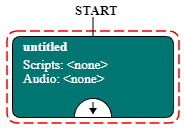
For each language you can enter a translated text in the field Script (for studio/voice). Would you like to add a new language? please make sure to add the language to the Tour first
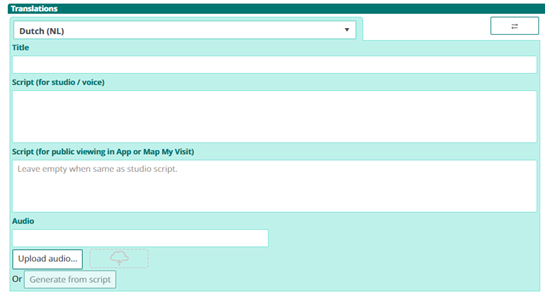
When you have entered the text, the Generate from script button lights up
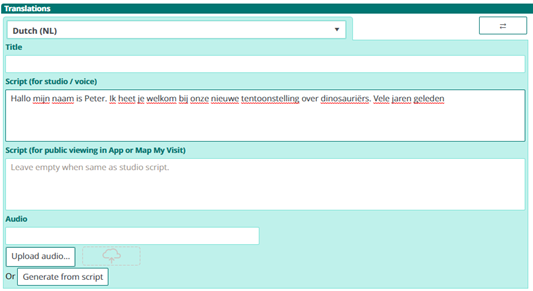
When you click on the button, an option will appear. In which you are asked whether you prefer a male or female voice.
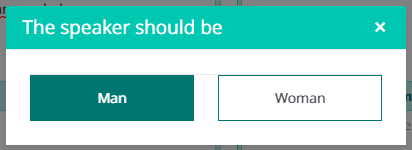
It will take a few seconds, depending on the length of the script to generate the audio clip. The mp3 file appears in the Audio field.

To listen to the clip, click on the Play button. If you are happy with the result, click on the Save button in the top right corner of your screen.
With the functionality Text-to-Speech you can convert text into an audio clip. This can be done in multiple languages. This functionality is built into the Portal, component TourEditor.
How?
In the Tour, you open the stop by clicking on the stop’s title. The clips associated with this stop will be displayed. Each green frame is a clip. You open the clip by double clicking on the green frame.

For each language you can enter a translated text in the field Script (for studio/voice). Would you like to add a new language? please make sure to add the language to the Tour first.

When you have entered the text, the Generate from script button lights up

When you click on the button, an option will appear. In which you are asked whether you prefer a male or female voice.

It will take a few seconds, depending on the length of the script to generate the audio clip. The mp3 file appears in the Audio field.

To listen to the clip, click on the Play button. If you are happy with the result, click on the Save button in the top right corner of your screen.
Guide-ID label orders, how does it work?
You will always receive our Podcatchers and IDentifiers with our standard Guide-ID labels. But If you would like to customize your labels you can! To do so, you can make use of our new design and ordering method.
Depending on the country you are located in, you will receive either an account or a link to a unique page where you can design and order your labels. Customers located in the Netherlands and Belgium will reveice an account from our Customer Support department. Customers located in other countries will be able to access their own unique page with a link they will receive from our Customer Support department.
Within this account / or on this page you can create, save, order and re-order your designs now and in the future. And you will also be able to order our standard Guide-ID labels and various StartIDentifiers labels you might need.
If you are already our customer and would like to order new or additional labels, you will also be able to use our new design and ordering method from now on! please contact our Customer Support at helpdesk@guide-id.com and we will make sure to set you up.
Would you like to re-order your current labels but cannot find them anymore?
Not to worry, let us know and we can email your current design so you can easily upload it into the design module to save and order again.
Always start designing and ordering in time so that you can receive the labels on time and start sticking! If you have any questions, we can always be reached by telephone of email.
Introduction
There are several ways to minimize the risk of losing Podcatchers. In this specsheet you’ll find a number of tips and best practices.
Other ways
When a visitor uses a Podcatcher, you can expect them to return it after use. However, some visitors may neglect, or simply forget to do so. To lower the amount of Podcatchers ‘disappearing’ over time, there are several ways to activate a warning signal built into the Podcatcher to alert visitors they should return the device.
Warning IDentifier 
The Podcatcher can sound its warning signal when it receives a Warning IDentifier code. This is a special IDentifier that is typically placed near the building exit so visitors should be notified at the right time.
Warning signal after idle time
The Podcatcher can also sound an warning signal when it is engaged in a Tour but has not played audio for a while. By default this functionality is turned off, but you can set it up in the Site Podcatcher settings, under “Podcatcher idle time before alarm starts”.
The advantage of this method is that the warning signal will always sound after a while, unless properly handed in. The disadvantages are that if you set it to sound the warning signal too quickly, visitors may become annoyed; if you set it to sound the warning signal too late, the visitor may already be on the bus back home by the time it goes off. Further, if your site doesn’t collect Podcatchers in docks after visitors finish the tour (such as a drop-off box), they may start to produce a very annoying chorus over time.
Post-Alarm trigger
The Podcatcher can be made to play audio after sounding the warning signal using the Post-Alarm trigger in a stop. This will make the stop play its audio after the warning signal has stopped playing (either due to it playing for its full duration or a button being pressed). This is – as all content is – localized to the language of the tour.
After having an office in the industrial area of Deventer for many years, we are excited to tell you that we are moving on the 1st of December 2020 to the city center of Deventer! Therefore we would like to ask you to adjust our address in your administration.
Our new address will be:
Guide-ID
Leeuwenbrug 117
7411 TH Deventer
The Netherlands
Our telephone number (+ 31 570 572202) and email adresses will remain unchanged. And If you are in the Netherlands, feel free to stop by for a nice cup of coffee!
As you know, on the 1st of December 2020 we will be moving to a beautiful new building in Deventer city center. And of course a move also includes a good clearance!
Not only the relocation, but also the latest product developments were reason enough for Guide-ID to take a critical look at our current product range. Together we decided a few products will not move along with us. Below you will find an overview which products will be taken out of our product range as of the 1st of January 2021 and how this will effect you.
Products that will be removed from the range (NL)
Products that will be removed from the range (UK)
With a thinned and clear product range for 2021, we are one step closer to the future; Standard “of the shelf” products with which we can serve our customers even quicker and simpler at home and abroad!
Please feel free to contact our Customer Support with whatever questions you may have about these changes!
Designing your own furniture
If you would like to design a furniture for our Podcatchers, you can choose between a design using loose Dockingstations or a design where you use a cabinet block which you slide into the furniture.
When you are designing a furniture this is what you need to keep in mind;
- The design is of course very dependent on the number of Podcatchers that you want to supply to your visitors. (Make sure to think about the future, when you might want to add players).
- Per 10 Podcatchers you will receive 1 Dockingstation
- When designing for loose Dockingstations; each Dockingstation has its own USB cable (and power-adapter with older Dockingstations) which needs to be connected to the Syncbox. So make sure to keep enough space available behind the Dockingstations for these cables (and extension courts when needed)
- Up to 10 Dockingstation (or 1 cabinet block) can be directly connected to one single Syncbox, which in turn needs to be connected to the internet. The cable length of the USB cable from each loose Dockingstation to the Syncbox is 90 CM, so the Syncbox needs to be placed near the Dockingstations. Because the USB cables also power the dockingstations, a Hub can not be used to extend the length of the cables.
- When using a Cabinet block the cables are already connected inside the block and the Syncbox is placed in the back if the block (see the manual)
- When designing for loose Dockinstations; keep room for the Syncbox(es). Depending on the set up, you will probably have to use multiple Syncboxes (100 Podcatchers can be connected to 1 Syncbox)
- It is also important to take into account where you place the Syncbox because it must be easily accessible if you have to restart it.
In addition, it is also important that you have easy access to the back of the furniture unit, if there are problems with a USB cable / power adapters /extension cords / switch etc.
- The entire setup must be connected 24/7 to power and a wired internet connection for the correct operation of the system.
- Also make sure the furniture has enough possibilities to ventilate warm air.
- Don’t place the top row with Dockingstations to high, otherwise you cannot see the lights (the status) of the Podcatchers
- Don’t place the bottom row with Dockingstations to low.
Each Podcatcher is equipped with a neck lanyard. When the Podcatchers are placed in the Dockingstations, the lanyards hang down. So if the bottom row is to low, the lanyards will hang on the floor.
- We recommend to place the lowest row of Dockingstations at a height of at least 100 cm from the ground. That way they are still easy to access for infants and visitors in a wheelchair.
- We have 4 info-graphics available that explain the handout of the Podcatcher which you can add to the (self-service) furniture if you like; https://help.guideid.com/kb/icons-for-signage/
Also important
We strongly advise not to use drawers in your furniture design for the distribution of the Podcatchers for several reasons; the USB cables (and power adapters) that are connected to each Dockingstation will be under tension constantly when sliding the drawers in and out. In addition, the cords can easily get stuck and you cannot properly detect wear on the wiring. Chances are also very high that cables are pulled from the Syncbox so no connection can be made when synchronizing, which in turn ensures that not all Podcatchers are synchronized
Take your visitor flow into account (with self-service, the amount of visitors able to access the furniture at the same time) and how you would like to lead them. When having one furniture for instance there are 2 flows; visitors who have just entered the museum and need to be able to easily access the furniture, to take out and activate a Podcatcher. While the second flow (visitors who are leaving the museum) must return their Podcatcher. These two flows should not interfere with each other.
Placement of the Start IDentifiers
To activate a language, you need to point your Podcatcher at a Start IDentifier. These are always placed at (or near) the distribution point.
You can either integrate them in the furniture or make a separate board where people can activate their Podcatchers (so separate from the furniture). A reason to do so, could be the visitor flow, or because of limited space around the furniture.
If you do integrate them into your furniture, please make sure not to place them flat (with a table design) or underneath the last row with Dockingstations (with a wall design).
Other important information about placing your (Start) IDentifiers can be found here.
Casing of the Identifiers
If you prefer to place the Identifiers in a casing, please keep in mind that our Identifiers are equipped with Bluetooth functionality. The Bluetooth signal cannot be transmitted through metal. This means that Identifiers cannot be placed in a metal casing.
Furniture examples
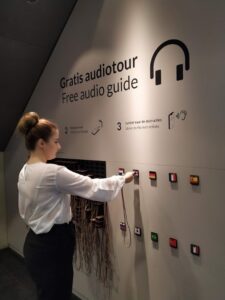


We have recorded a few standard phrases which you can use and add to your audio guide. E.g. “please make sure to keep 1 ½ meter distance from each other. Follow the one-way path in the museum to avoid having too many people in one area.”
The phrases are available in 4 languages and can be downloaded using the following links;
Covid 19 – Text & Audio – NL
Covid 19 – Text & Audio – EN
Covid 19 – Text & Audio – FR
Covid 19 – Text & Audio – BE
Tip! You can also use the text provided in the examples above to translate and record in other languages.









